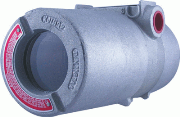
Vision inspection systems have often replaced their human counterparts in industrial inspection applications because they can operate faster, continuously if necessary and with a fixed level of consistency. However one potential use of vision systems is to protect human operators from working in adverse environmental conditions, such as high temperatures, bio-hazards, toxic or explosive environments or radioactive areas
Developments in vision technology allow operators to be moved a greater distance away from production lines of dangerous materials such as molten steel, titanium or glass, thus enhancing production line safety. Perhaps the simplest use of vision systems is that of simply imaging gauges or displays that are located in the hazardous area.
The operator in the control room can then record the data as if it were being read directly. Image processing software could be used to extract the reading from the image so it can be recorded, in order to eliminate any manual recording errors. An application of the use of machine vision in the traditional sense might be to make automated measurements of the size and volume of nuclear fuel pellets – essential parameters for determining fission levels. One commonly used application of vision in hazardous areas is in conjunction with robotics.
Robot applications
In industrial environments, vision systems are used for robot guidance and barcode reading. In industrial spray painting applications such as in the automotive industry, there can be many different components to be sprayed. A vision system attached to the robot can read a barcode on the component to tell the painting robots which spray pattern program to run.
 Components for safety
Components for safety
The introduction of the GigE Vision data transmission standard has been potentially one of the most important developments in vision technology for applications in environmentally unfriendly areas. The ability to transmit images over distances of up to 100 metres using Ethernet components means image processing computers can be located in a control room, well away from the dangerous area. This standard allows high resolution high speed cameras from any vendor to be chosen for their suitability for the application.
Care must also be taken to protect vision components which are exposed to the local environmental conditions. Cameras and illumination sources can be protected in specially designed enclosures. In some cases, the camera must be protected from the environment, whereas in potentially explosive environments such as in the petro-chemical industry or other volatile chemical processes such as paint spraying, the environment is protected from any possibility of exposure to a source of ignition from the camera electronics using explosion-proof camera and illumination enclosures.
For applications in high temperature areas, there may be the need to protect cameras and components from radiated heat using water-cooled enclosures, or from IR radiation using special filters. High dynamic range cameras are available with a dynamic range in excess of 1,000 times that of conventional CCD sensors. This opens up a host of inspection applications in the iron and steel industries by allowing image detail to be obtained simultaneously from very bright areas such as the hot metal or furnace areas as well as dark areas, without loss of contrast, or saturation of the image. For applications in the nuclear industry, the problem is the degradation of the camera sensor by the radiation. Since it may not be easy to replace cameras when they fail, one solution is to install multiples of cheaper cameras allowing a ‘reserve’ camera to be brought on line if one camera fails without entering the radioactive area.
Vision in a furnace environment
Float glass production accounts for around 95 per cent of the world’s production of flat glass. The raw materials are introduced into a furnace where they are melted at 1,500°C. The molten glass then flows from the glass furnace into a bath of molten tin in a continuous ribbon. The glass is pulled through the bath on rollers to produce a flat sheet, which then goes into an annealing area where various coatings can be applied and the glass is cooled to a temperature, where automated, high speed inspection can be used to reveal defects. Identification of defects can be related back to process faults upstream that can be corrected and the data can also be used to steer downstream cutters round the flaws for automatic removal of defect glass which can be recycled into a future batch. Although the inspection does not take place at high temperatures, it ensures the high-temperature process can be automated and keep personnel away from a generally high temperature area.
Automated warehousing
In a warehouse lifting heavy goods, or falling goods can cause human injury. By automating stocking and retrieval of goods from warehouses using code-reading vision systems to monitor stock levels and identify the correct locations for storage, potential injury can be avoided.


